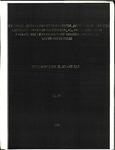An integrated ecotoxicological assessment of the engineered nanoparticles, C60 fullerenes in different life stages of marine mussels, Mytilus edulis
| dc.contributor.supervisor | Jha, Awadhesh | |
| dc.contributor.author | Al-Subiai, Sherain | |
| dc.contributor.other | Faculty of Science and Engineering | en_US |
| dc.date.accessioned | 2011-07-25T15:49:14Z | |
| dc.date.available | 2011-07-25T15:49:14Z | |
| dc.date.issued | 2011 | |
| dc.date.issued | 2011 | |
| dc.identifier | 10007332 | en_US |
| dc.identifier.uri | http://hdl.handle.net/10026.1/536 | |
| dc.description.abstract |
Studies were undertaken to determine ecotoxicological effects of model manufactured or engineered nanoparticles (ENPs), either alone or in combination with a representative polycyclic aromatic hydrocarbon (i.e. PAHs: fluoranthene) at different levels of biological organisation (viz. biochemical, histological and behavioural levels) in a sentinel, widely distributed marine invertebrate species, Mytilus edulis. With the current and predicted levels of pollution in the marine and coastal environment, there is an urgent need to establish the potential effects of persistent and emerging contaminants which includes ENPs and PAHs, to protect human and environmental health. In this study, initially, it was aimed to optimise the induction of biotransformation enzyme P-450 as a robust biochemical tool and good progress (chapter 3) was made to standardise P-450 in mussel. Due to certain technical and logistic limitations however we could not apply measurement of P-450 as potential biochemical biomarkers in this species. The possibility of using glutathione levels instead in the cell-free component of haemolymph samples as an indicator of oxidative stress, in an analogous way to that used in mammals was evaluated (chapter 4). The evidence suggested that cell-free haemolymph samples collected from adductor muscle of Mytilus edulis may be significantly contaminated with intracellular contents of myocytes of this organ (i.e. adductor muscle) and adductor muscle tissue is more generally useful to determine glutathione system responses. The validation study of different assays using copper as a relevant environmental contaminant (chapter 5) suggested the existence of clear relationships between genotoxic (as determined by induction of DNA strand breaks using the Comet assay) and higher level effects. The results further suggested the feasibility of adoption of an integrated approach and robustness of selected biomarkers to evaluate short and long-term toxic effects of pollutants. A multiple biomarker approach was then used to determine the potential interactive effect of C60 fullerenes in combination with fluoranthene. Where appropriate analytical tools (i.e. ICP-MS, GC-MS) were used to determine the levels of contaminant exposure and characterise the properties of the ENPs. The combined exposure of fluoranthene and C60 fullerenes produced enhanced biological damage at approximately at an- “additive” rather than synergistic level, which appeared to be as a result of oxidative stress (chapter 6). The final experiments were carried out in both the early and adult life stages to test the potential toxicity resulting from photochemical transformation of C60 fullerenes in Mytilus edulis (chapter 7). In general, the results showed, for the first time, genotoxic and developmental impact of the photochemically transformed C60 fullerenes at different life stages of marine mussel. Further research is required to identify the degraded products of C60 fullerenes and to understand the mechanism by which fresh and aged C60 fullerenes induces biological responses including oxidative stress and affect ecologically relevant aquatic organisms at different life stages. The thesis has taken the opportunity to discuss (chapter 8) the importance of applications of biological responses in hazard and risk assessment posed by anthropogenic chemicals in a broader context. | en_US |
| dc.language.iso | en | en_US |
| dc.publisher | University of Plymouth | en_US |
| dc.subject | Nanoparticles | en_US |
| dc.subject | Life Stages | en_US |
| dc.subject | Mytilus edulis | en_US |
| dc.subject | PAHs | en_US |
| dc.title | An integrated ecotoxicological assessment of the engineered nanoparticles, C60 fullerenes in different life stages of marine mussels, Mytilus edulis | en_US |
| dc.type | Thesis | |
| dc.identifier.doi | http://dx.doi.org/10.24382/4847 |
Files in this item
This item appears in the following Collection(s)
-
01 Research Theses Main Collection
Research Theses Main


